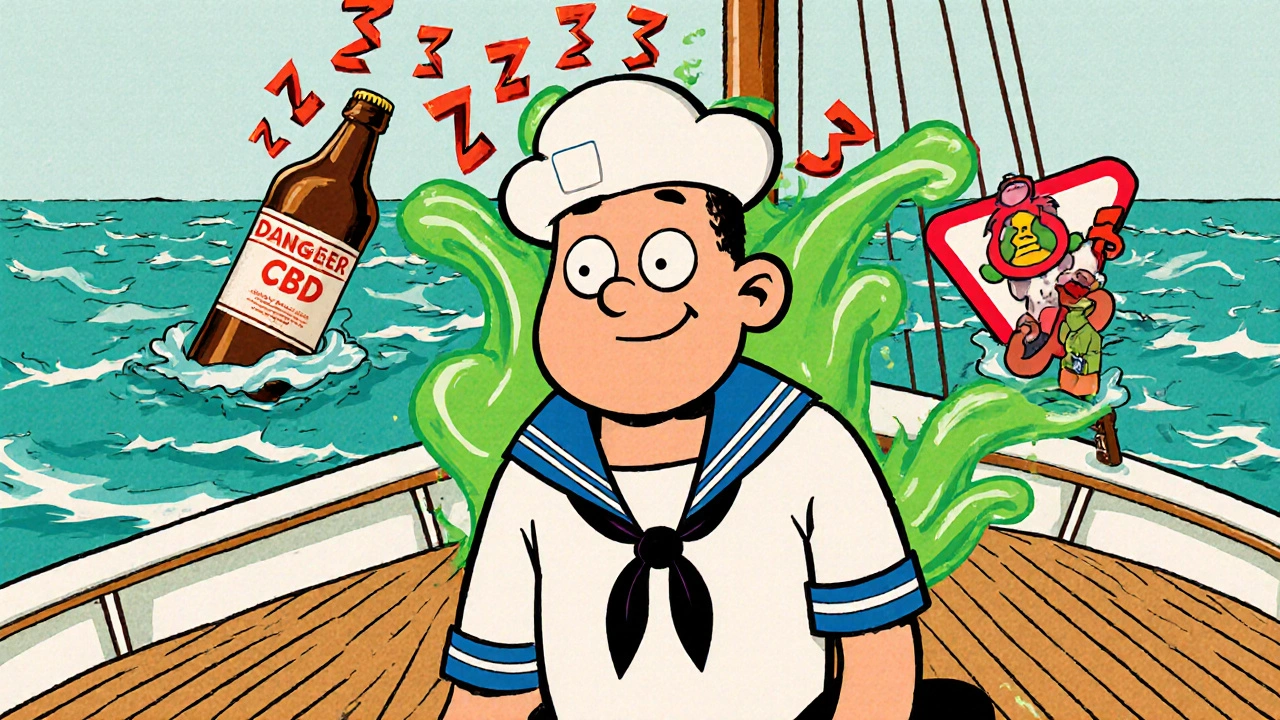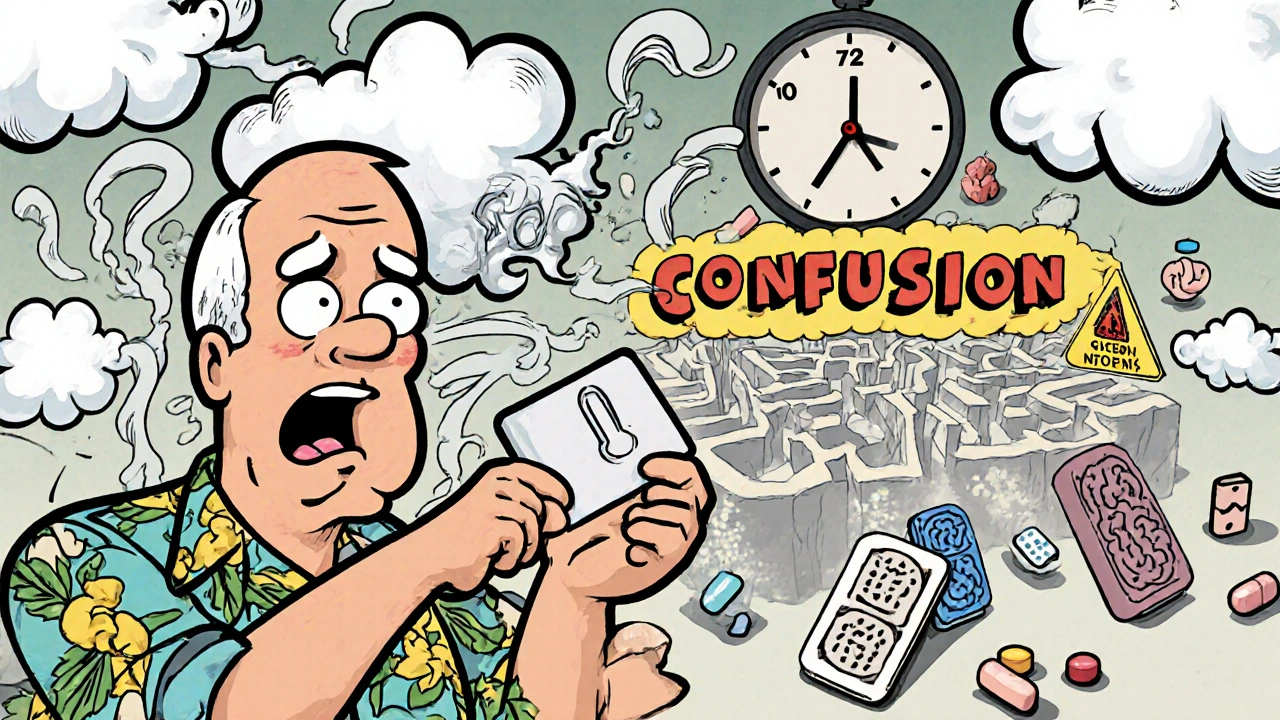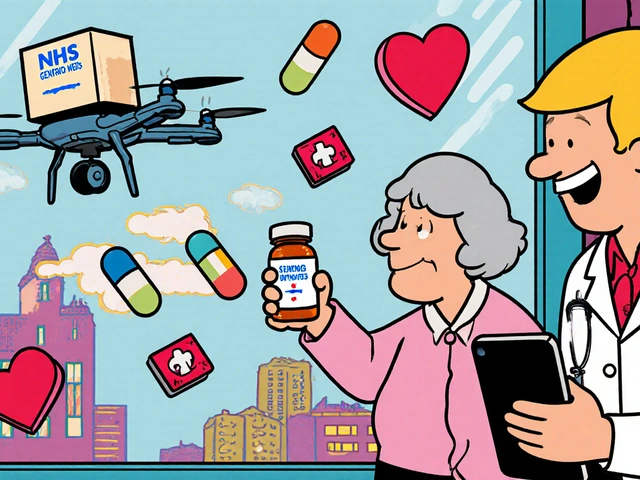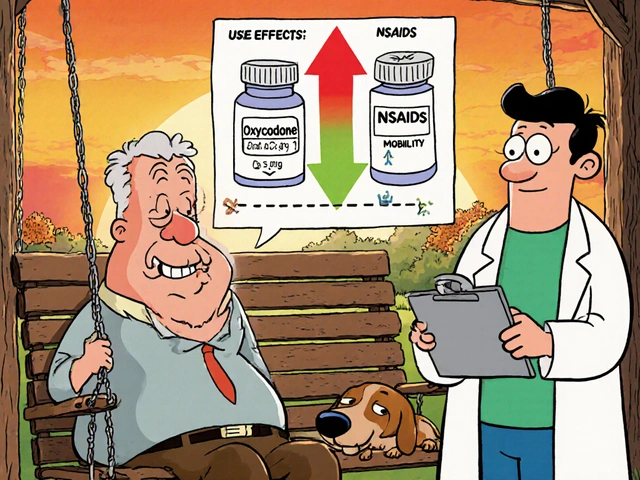
Scopolamine Sedative Interaction Checker
Assess potential risks when combining scopolamine patch with other substances. Based on FDA and medical guidelines.
When you’re on a boat, in a car, or flying through turbulence, motion sickness can hit hard. For many, over-the-counter pills like Dramamine or Bonine help-but they wear off fast. Enter scopolamine, the most effective single drug for preventing motion sickness. It comes as a patch behind the ear, works for up to three days, and doesn’t need repeated dosing. But here’s the catch: it doesn’t just stop nausea. It makes you sleepy. And when you mix it with other sedatives-alcohol, sleep aids, painkillers, even CBD-the drowsiness can turn dangerous.
How Scopolamine Actually Works
Scopolamine, also known as hyoscine, blocks acetylcholine, a brain chemical that helps control balance, nausea, and muscle movement. It’s not new-used since the early 1900s-and it’s on the World Health Organization’s list of essential medicines. The patch, called Transderm Scōp, delivers about 0.5 mg per day through the skin, slowly building up in your system. It starts working after four hours, peaks around day one, and lasts up to 72 hours. That’s why it’s popular among cruise passengers, military pilots, and commercial fishermen who can’t stop for pills mid-voyage.
Unlike oral meds that need re-dosing every 4-8 hours, the patch gives steady levels. Blood concentrations stay between 0.2-0.7 ng/mL, which is enough to stop vomiting but not so high that it causes hallucinations-at least, not usually. Still, because it crosses the blood-brain barrier easily, it affects your central nervous system more than other anti-nausea drugs.
Why Sedation Is the Biggest Side Effect
Of everyone who uses the scopolamine patch, 45% report drowsiness. That’s more than double the rate seen with meclizine or dimenhydrinate. Dry mouth (67%) and blurred vision (32%) are common too. But it’s the sleepiness that makes people stop using it-or worse, mix it with something else.
Real users tell the story. On Reddit, one person wrote: “Worked great for seasickness… knocked me out completely. Had to take it off and switch to Dramamine.” Another said: “The drowsiness helped me sleep through rough seas.” That’s the double-edged sword. For some, it’s a bonus. For others, it’s a dealbreaker.
Studies back this up. A 2019 trial with 150 people in motion simulators showed scopolamine reduced symptoms by 78.3%. Dimenhydrinate? Only 64.2%. But the trade-off? Scopolamine users were far more likely to feel foggy, slow, or confused. In fact, 58% of adverse events happen during first-time use because people don’t expect how strong the sedation is.
The Real Danger: Mixing with Other Sedatives
Scopolamine doesn’t just make you tired. It can slow your breathing, lower your blood pressure, and cloud your thinking-especially when combined with other central nervous system depressants.
Here’s what you absolutely shouldn’t mix it with:
- Alcohol: Even one drink can triple your risk of disorientation. Marine crew members report colleagues becoming severely confused after just a beer while wearing the patch.
- Benzodiazepines (like Xanax, Valium): These increase the chance of delirium in people over 65 by 40% compared to scopolamine alone.
- Opioids (like oxycodone, hydrocodone): The combination raises the risk of respiratory depression by 3.2 times in animal studies.
- CBD products: New data from 2024 shows CBD may inhibit liver enzymes that break down scopolamine, making sedation 22-35% stronger.
- Sleep aids (like zolpidem, diphenhydramine): These stack on top of scopolamine’s drowsiness, making it hard to wake up or respond in an emergency.
The European Medicines Agency and the American Society of Anesthesiologists both warn against combining scopolamine with any CNS depressant without close monitoring. The FDA’s label says it plainly: “Do not use with other anticholinergics or sedatives.” Yet, 41% of negative reviews on Drugs.com mention alcohol as the cause of bad reactions.

Who Should Avoid Scopolamine Altogether
Not everyone can use it safely. You should not use the patch if you have:
- Glaucoma (it increases eye pressure)
- Myasthenia gravis (it worsens muscle weakness)
- Blockages in your stomach or intestines
- Severe cognitive impairment or dementia
Also, it’s not recommended for pregnant women (FDA Category C) or children under 18 unless under direct medical supervision. Older adults are especially vulnerable. Their bodies process drugs slower, and their brains are more sensitive to anticholinergic effects. Delirium in seniors after scopolamine use isn’t rare-it’s well-documented.
How to Use It Safely
If you decide to try the patch, here’s how to do it right:
- Apply it to clean, dry skin behind your ear at least 4 hours before travel. Some experts recommend applying it the night before so you can sleep through the first wave of drowsiness.
- Don’t touch the sticky side. Wash your hands after applying.
- Remove it after 72 hours, or sooner if side effects become overwhelming.
- Wait at least 12-24 hours after removal before driving, operating machinery, or making important decisions. Effects linger even after removal.
- Avoid alcohol completely during and for 24 hours after patch use.
- If you feel too drowsy, remove the patch. Symptoms usually fade within a day.
Some people cut the patch in half to reduce the dose. This is off-label, not approved by manufacturers, and can lead to inconsistent absorption. Don’t do it unless your doctor specifically tells you to.
What’s Next for Motion Sickness Treatment
Scopolamine remains the gold standard-but it’s not perfect. The FDA approved a new low-dose patch (0.5 mg over 3 days) in April 2024, designed to cut sedation while keeping effectiveness. Early results show promise.
Researchers are also testing a patch that releases caffeine slowly to counteract drowsiness. It’s in Phase III trials right now, with results expected by late 2025. Another compound, penehyclidine hydrochloride, shows similar anti-nausea power with 37% less sleepiness-but it’s still years away from being available.
Meanwhile, the market is shifting. Only 38% of people who consider scopolamine actually use it, mostly because of fear of side effects. That’s why the global antiemetic market is growing slower for scopolamine than for other motion sickness drugs-despite its unmatched effectiveness.
Final Thoughts: Efficacy vs. Safety
Scopolamine works better than anything else for motion sickness. If you’re on a long trip and can’t afford to be sick, it’s your best bet. But it’s not a casual drug. It’s a powerful tool with serious risks if misused.
If you’re planning to use it, talk to your doctor. Tell them everything you take-even over-the-counter supplements. Don’t assume “natural” means safe. CBD, melatonin, and even some herbal teas can interact. And never, ever mix it with alcohol.
For short trips, meclizine might be a better fit. For long hauls, scopolamine still wins-but only if you respect its power. It’s not just a patch. It’s a chemical that changes how your brain works. Treat it that way.
Can I drink alcohol while using a scopolamine patch?
No. Mixing alcohol with scopolamine significantly increases drowsiness, confusion, and risk of respiratory depression. Even one drink can cause severe disorientation, especially in older adults. The FDA and European Medicines Agency both warn against combining the two. If you’re wearing the patch, avoid alcohol entirely during use and for at least 24 hours after removal.
How long does scopolamine stay in your system?
Scopolamine has a half-life of 4-6 hours, meaning half of it leaves your bloodstream in that time. But because the patch delivers it slowly over 72 hours, effects can linger. Most people feel normal within 12-24 hours after removing the patch, but traces can be detected in urine for up to 48 hours. Cognitive effects, like slowed reaction time, may last longer-especially if combined with other drugs.
Is the scopolamine patch safe for seniors?
It carries higher risks for people over 65. Studies show a 40% increase in delirium when combined with benzodiazepines, and even scopolamine alone can cause confusion, memory issues, or urinary retention in older adults. The American Society of Anesthesiologists advises extreme caution. If a senior needs motion sickness prevention, alternatives like meclizine or non-drug methods (ginger, acupressure) are often safer.
Can I use scopolamine with CBD oil or gummies?
Not without caution. Early 2024 research shows CBD may inhibit liver enzymes (CYP3A4) that break down scopolamine, leading to higher blood levels and stronger sedation-by 22-35%. Since CBD products aren’t regulated, dosage and purity vary widely. The American Medical Association warns this interaction is poorly understood and potentially dangerous. Avoid combining them unless under medical supervision.
What should I do if I feel too drowsy with the patch?
Remove the patch immediately. Symptoms like extreme sleepiness, confusion, or trouble speaking usually improve within 12-24 hours after removal. Do not drive, operate machinery, or make critical decisions until you feel fully alert. If symptoms persist beyond 24 hours or include hallucinations, rapid heartbeat, or difficulty urinating, seek medical help right away.
Are there better alternatives to scopolamine?
For short trips or if you need to stay alert, meclizine (Bonine) or dimenhydrinate (Dramamine) are good options. They’re less effective than scopolamine but cause less cognitive impairment. For longer trips, the new low-dose scopolamine patch (approved in 2024) offers similar anti-nausea effects with less drowsiness. Non-drug options like ginger supplements, acupressure wristbands, or focusing on the horizon can help too-especially when combined with other methods.





